|
 THE HOUSE OF FEAR ABOVE-PAR SHERLOCK HOLMES ENTRY THE HOUSE OF FEAR ABOVE-PAR SHERLOCK HOLMES ENTRY
One of the better entries in Universal's long-lived Sherlock Holmes
series, "The House of Fear" will fully satisfy in action spots and
make a good supporting dualler in the naborhoods. Based on the Conan
Doyle tale, "The Adventures of the Five Orange Pips," this is laid in
the shuddery setting of Drearcliff, a mysterious Scottish mansion
inhabited by a half-dozen retired gentlemen each of whom receives a
warning before meeting a violent death. Even Sherlock Holmes, who is
aided by the loyal, blundering Dr. Watson and later annoyed by the
bluff Inspector Lestrade of Scotland Yard, is stumped for a while, but
he finally reveals an amazing solution —
one that will come as a complete surprise to even the cleverest of the
who-dun-it enthusiasts. Although the early scenes are slow-moving, the
climax has both suspense and excitement and there is no romance to
distract one's attention from the gruesome happenings. Basil
Rathbone, as the imperturbable Holmes; Nigel Bruce, as the faithful
Dr. Watson, and Dennis Hoey, as the not-quite-bright Inspector
Lestrade, give standard portrayals, while Aubrey Mather and Paul
Cavanagh are excellent as the last two surviving members of "The Good
Companions" club who have watched their cronies receive a death
warning. The three women in the cast have minor parts.
Each member of a group of English clubmen who live together in a
somber old Scottish mansion has a large insurance policy upon himself,
made out to the surviving members of the club. Shortly after a message
containing only five orange pips is received, one of the members dies
horribly in a car crash and , the next night, another is killed after
receiving an envelope with four orange pips. Sherlock Holmes and Dr.
Watson are called into the case but he is unable to stop the violent
deaths of Holmes Herbert and Harry Cording, two of the other members.
When only Paul Cavanagh and Aubrey Mather are left, the murder of a
village tobacconist leads Holmes to the solution. In a surprise move,
Dr. Watson is kidnapped but Holmes discovers an old smugglers' tunnel
which leads to a cave where he finds the club members all very much
alive. Using Aubrey Mather as an innocent dupe, the others had
intended to collect the insurance by robbing local graves and
mutilating each corpse so that the authorities could not learn that it
was not one of the club members who had, apparently, met a violent
death.
York
—Film Bulletin,
April 16, 1945 |
"It's hardly believable, but the ensemble cast play this hokey murder mystery
to the hilt and the surprise ending seems to make sense. It's entertaining
despite its slow pace and other structural flaws." Dennis Schwartz,
Ozus' World Movie Reviews

Holmes shushes Watson |
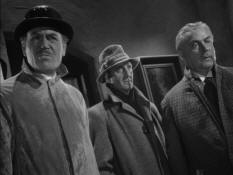
Lestrade, Holmes, and Watson |
"Rathbone and Bruce are both in fine form. Dennis Hoey as Inspector
Lestrade shares the comic relief duties with Nigel Bruce but fortunately
the comic elements are not overdone. There is plenty of amusement but
the focus is on the mystery, and on the gothic possibilities of a large
old house in an isolated setting. The gothic sensibility is very strong indeed in this movie. Gothic
atmosphere was something that Universal could be relied on to do supremely
well in those days and director Roy William Neill pulls out all the stops.
...
As is the case with the rest of the Rathbone/Bruce movies production
values are high. The house and the remote location are used skillfully.
This might be a B-movie but it’s a classy and very professionally made
B-movie."
Classic Movie Ramblings
 This latest of the "Sherlock Holmes" murder mystery
melodramas is below par for the series. It should, however, serve its
purpose as a supporting feature. There is nothing unusual about the
production, most of it being repetitious of the previous pictures. The
story and treatment follow the usual formula—that
is, mysterious murders are committed, "Holmes" is called in on the
case, and through his amazing though implausible powers of deduction,
and with the aid of his trusty friend, "Dr. Watson," clears up the
mystery. The action slows down considerably in spots, and the suspense
usually found in pictures of this type is lacking:— This latest of the "Sherlock Holmes" murder mystery
melodramas is below par for the series. It should, however, serve its
purpose as a supporting feature. There is nothing unusual about the
production, most of it being repetitious of the previous pictures. The
story and treatment follow the usual formula—that
is, mysterious murders are committed, "Holmes" is called in on the
case, and through his amazing though implausible powers of deduction,
and with the aid of his trusty friend, "Dr. Watson," clears up the
mystery. The action slows down considerably in spots, and the suspense
usually found in pictures of this type is lacking:—
Called upon to solve the mysterious
deaths of two wealthy men, members of an exclusive club known as "The
Good Comrades," Holmes (Basil Rathbone), accompanied by his friend,
Dr. Watson (Nigel Bruce), goes to the Scottish mansion where the club
members lived. There he learns that each of the members, of whom five
were alive, carried a large insurance policy upon himself, payable to
the last surviving member of the club. Holmes learns also that, in
each death, the victim was so mutilated that his body was barely
recognizable. Different clues lead Holmes to suspect one or another of
the members of murdering his comrades and, during this investigation,
additional murders are committed until the club is reduced to two
surviving members. Meanwhile several attempts are made on his and Dr.
Watson's life. Holmes finally discovers a solution to the crimes
though the murder of a village tobacconist, who had been shot after
declaring that he had seen one of the murdered men walking on the
beach. Following up this clue, Homes discovers an underground tunnel
leading from the mansion to the sea, where he finds the supposedly
murdered club members very much alive. He proves that they had robbed
graves and had disguised the corpses to appear like each of them in an
ingenious scheme to collect the insurance money.
Roy Chanslor wrote the screen play
based on the "Adventures of the Five Orange Pips" by Sir Arthur Conan
Doyle. Roy Williams Neill produced and directed it. The cast includes
Aubrey Mather, Dennis Hoey, Paul Cavanagh and others.
Unobjectionable morally.
—Harrison's Reports,
March 24, 1945 |
"'The House of Fear' is
a good old fashioned spooky murder mystery with references to the original
story, 'The Five Orange Pips.' It features mutilated corpses, secret
passages, a remote Scottish castle and eccentric characters. There are
some good performances, with a particularly entertaining Inspector Lestrade and Bruce Alistair."
http://www.rathboneandbruce.net/the-house-of-fear.html
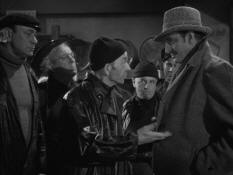
A fisherman give Holmes an important clue. |

Lestrade and Holmes |
"... one of the neatest and most effective of the Universal Holmes
mysteries. Throughout, the special effects department was kept busy with
providing howling winds, thunder and lightning which, added to the dimly
lit interiors, give the film a suitably mysterious and sinister mood."
David Stuart Davies, Holmes of the Movies (New York: Bramhall
House, 1976)
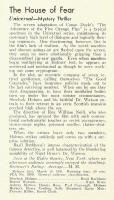 The
screen adaptation of Conan Doyle's "The Adventure of the Five Orange
Pips" is a typical specimen in the Universal series, maintaining its
customary high level of dialogue and logically flowing sequences. One
shortcoming, however lies in the film's lack of realism. As the weird
murders and obscure going-on are flashed upon the screen, they seem no
more emotionally gripping than a disassembled jig-saw puzzle. Even
when murders begin multiplying at Holmes' feet, he appears as
unstirred and mechanical as though he were working out some
cryptogram. The
screen adaptation of Conan Doyle's "The Adventure of the Five Orange
Pips" is a typical specimen in the Universal series, maintaining its
customary high level of dialogue and logically flowing sequences. One
shortcoming, however lies in the film's lack of realism. As the weird
murders and obscure going-on are flashed upon the screen, they seem no
more emotionally gripping than a disassembled jig-saw puzzle. Even
when murders begin multiplying at Holmes' feet, he appears as
unstirred and mechanical as though he were working out some
cryptogram.In the plot, an eccentric company of seven retired
gentlemen, calling themselves "The Good Comrades," have insurance
policies made out to the last surviving member. When one by one they
start disappearing, to have their mutilated bodies turn up under the
most sinister circumstances, Sherlock Holmes and his faithful Dr.
Watson entrain to their retreat in an eerie Scottish mansion perched
high above the sea.
The direction of Roy William Neill, who also produced, has sprayed
the film with such conventional melodramatic touches as secret
passageways, storm-swept nights, poisoned needles, clatter-shutters,
etc.
When the crimes leave only two members, Holmes strikes suddenly and
comes up with a surprise solution.
Basil Rathbone's intense characterization of the famous detective,
is well balanced by the blundering amiability of Nigel Bruce's Dr.
Watson.
Seen at the Rialto theatre, New York, where an afternoon
audience seemingly enjoyed the sleuthing. Reviewer's Rating: Average. —M.
H.
—Motion Picture Herald,
March 24, 1945 |
The Universal Sherlock Holmes films, "churned out though they were, had
in all of them moments to cherish. But The House of Fear was
perhaps the last fully satisfying entry in the series." Chris Steinbrunner
and Norman Michaels, The Films of Sherlock Holmes (Secaucus, NJ:
Citadel Press, 1978)

Lestrade and Holmes investigate a hidden passageway. |
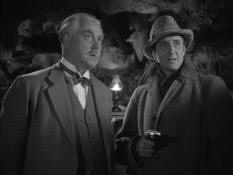
The Good Comrades' scheme is exposed. |
"Roy Chanslor's muddled screenplay, based on Conan Doyle's 'The Adventures of
the Five Orange Pips,' was rather a bore and Roy William Neill's efforts to
instill some life into it were unsuccessful. ... Rathbone seemed to be a bit
weary of the detective role by this time."
Michael B. Druxman, Basil Rathbone: His Life and His Films, (Hardcover: South Brunswick
and New York: A.S. Barnes, 1975; Paperback edition: BearManor Media,
2011)
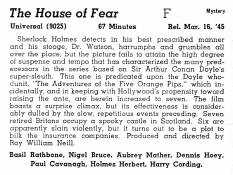 Sherlock
Holmes detects in his best prescribed manner and his stooge, Dr.
Watson, harrumphs and grumbles all over the place, but the picture
fails to attain the high degree of suspense and tempo that has
characterized the many predecessors in the series based on Sir Arthur
Conan Doyle's super-sleuth. This one is predicated upon the Doyle
whodunit, "The Adventures of the Five Orange Pips," which
incidentally, and in keeping with Hollywood's propensity toward
raising the ante, are herein increased to seven. The film boasts a
surprise climax, but its effectiveness is considerably dulled by the
slow, repetitious events preceding. Seven retired Britons occupy a
spooky castle in Scotland. Six are apparently slain violently, but it
turns out to be a plot to bilk the insurance companies. Produced and
directed by Roy William Neill. Sherlock
Holmes detects in his best prescribed manner and his stooge, Dr.
Watson, harrumphs and grumbles all over the place, but the picture
fails to attain the high degree of suspense and tempo that has
characterized the many predecessors in the series based on Sir Arthur
Conan Doyle's super-sleuth. This one is predicated upon the Doyle
whodunit, "The Adventures of the Five Orange Pips," which
incidentally, and in keeping with Hollywood's propensity toward
raising the ante, are herein increased to seven. The film boasts a
surprise climax, but its effectiveness is considerably dulled by the
slow, repetitious events preceding. Seven retired Britons occupy a
spooky castle in Scotland. Six are apparently slain violently, but it
turns out to be a plot to bilk the insurance companies. Produced and
directed by Roy William Neill.—Box
Office Digest, March 24, 1945 |
"Among the ace cards in director Roy William Neill’s 1945 thriller’s
winning hand are a load of appropriately doomy and gloomy atmosphere, a
nice creepy, menacing mood and of course the dignified performances of the
classy star duo, who are effectively balanced by the comic relief of
Dennis Hoey’s amusingly slow-witted Inspector Lestrade." Derek Winnert,
derekwinnert.com
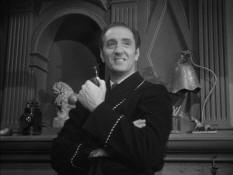
Holmes is amused by Watson's telling of the tale. |
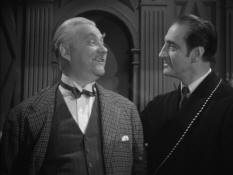
Holmes and his friend Watson |
"The House of Fear gets closer to the Sir Arthur Conan Doyle spirit
than any of this series has the past couple of seasons. They have been
throwing Sherlock in among monsters and Nazis lately, but not in this new
one at the Rialto. The opportunity to slip back into the mood of
preoccupation and elaborate talk of the original is just the thing for
Basil Rathbone's florid style of acting, of course. If one of your main
interests in the series has been the way he played Sherlock, this will be
among the very best." Alton Cook, New York World-Telegram,
March 17, 1945
See Page Three for pictures of posters,
lobby cards and promo photos.
Back to Page One of The House of Fear
Back
to Sherlock Holmes films
The House of Fear
is available on DVD:

Click to order |
DVD also available as part
of The Sherlock Holmes Collection, Volume 2:

Click to order |
.
|




















